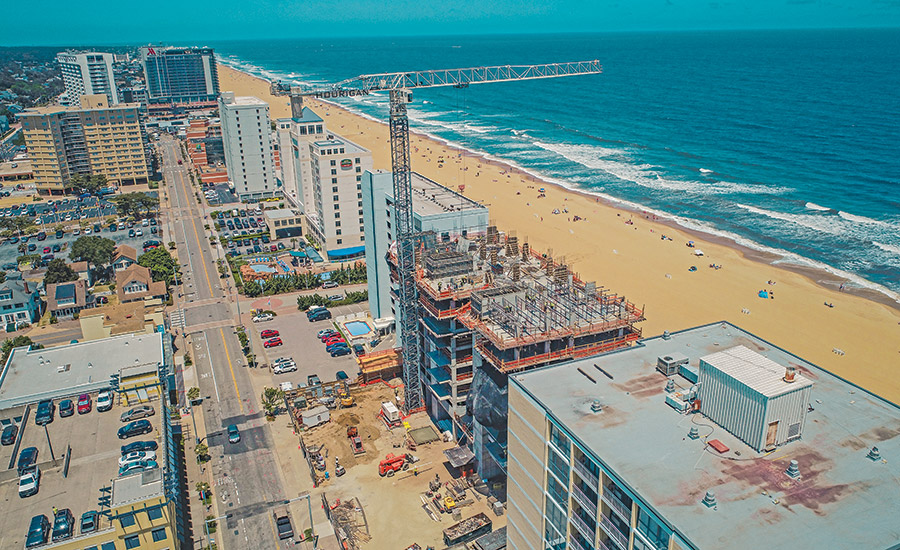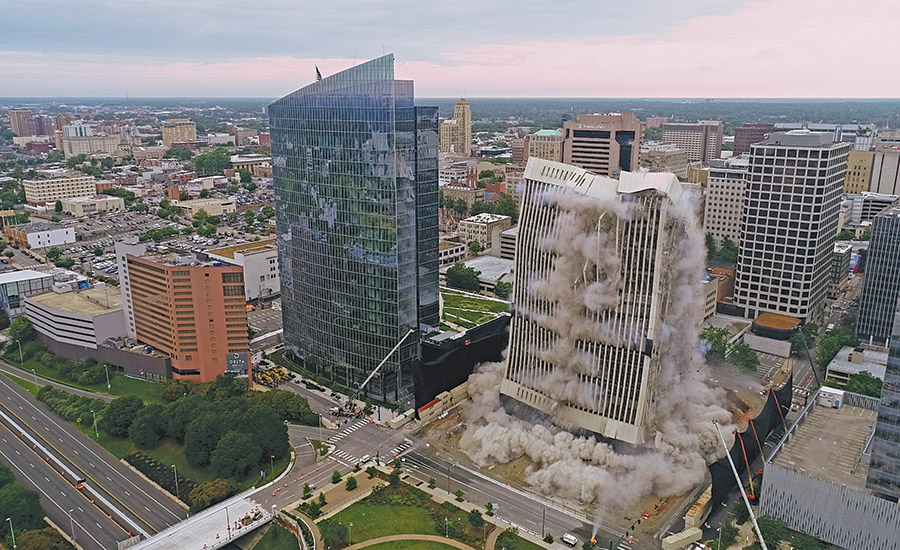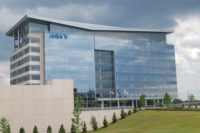Few contractors were better positioned to weather the disruptions and uncertainties of 2020 than Richmond, Va.-based Hourigan. Thanks to a deep, diverse project backlog, the company—ENR MidAtlantic’s Contractor of the Year—powered through the pandemic to see its revenue climb 39%, to $466 million. That result continues a 146% increase in revenue since 2015. The revenue boost catapulted the firm to No. 17 from No. 29 on the ENR MidAtlantic Top Contractor rankings.
But Mark Hourigan, the company’s founder and chief executive, insists that numbers tell only part of the story. It is true that the 250-person company entered the year with strong activity around its three offices—Richmond, Charlottesville and Hampton Roads. But 2020 might have turned out quite differently had Virginia not deemed construction an essential business, or if clients had elected to put a pause on new or ongoing work.
“Every one of our clients made the commitment to continue with their projects,” Hourigan says. “That kept the doors open and things happening on jobsites.”
Taking Covid-19 protocols seriously helped ensure that activity happened safely, Hourigan adds. That resulted in no site shutdowns and only a handful of positive tests.
“We got everyone involved in the effort by making it personal,” notes Elizabeth Eshbach, an assistant project manager who joined Hourigan in 2016. In addition to routine measures, project teams have held monthly safety slogan contests to encourage mask-wearing.
Eshbach’s favorite contest entry: “Mask It or Casket.”
“Super relationship-oriented”

The Hyatt Place is a 150,000-sq-ft, post-tensioned cast-in-place structure located along the Virginia Beach oceanfront on a tight site between adjacent buildings.
Photo courtesy of Hourigan
Building trust and fulfilling commitments to clients, partners and employees have been fundamental to the firm’s culture since Hourigan formed the company in 1994, following stints with Westinghouse and another Virginia construction company. The result is a wide-ranging portfolio of clients and projects, ranging from the commonwealth’s leading corporations and universities to nonprofits and developers of residential and commercial properties.
“Hourigan is super relationship-oriented, and it all starts with Mark,” observes Bill Chilton, a partner with New Haven, Conn., architecture firm Pickard Chilton. The firm teamed with Hourigan on 600 Canal Place, Dominion Energy’s new 20-story downtown Richmond headquarters, completed in 2019. Chilton adds, “He knows the complexities of the business and how to work effectively with everyone of every background, from a new tradesperson to a corporate CEO.”
Chilton also praises the firm’s ability to see projects through a different construction-related lens, including value engineering opportunities to reduce costs and communicating effectively with owners and partners. Those are attributes that he found particularly helpful for the nuances of design-build, a project delivery method in which he had little personal experience.
“The big thing in design-build is trust, and we were fortunate to have their experience,” he says.
Hourigan says his firm’s willingness to share its expertise comes from its long-standing tradition of taking on new kinds of projects. “The more complex, challenging or fast-track it is, the better,” Hourigan says. “We dive into those projects because we have smart, hard-working people who like a challenge.”
Those qualities have been important for the company’s work at Richmond’s Virginia Commonwealth University. Current projects for the university include the 1-million-sq-ft VCU Health Adult Outpatient Pavilion, which consolidates disparate health care services into a more accessible location, and a five-story, 100,000-sq ft STEM facility that aims to help foster collaboration across a variety of science and technology disciplines.
“These are very large projects that have a lot of complex user-specific considerations,” says VCU President Michael Rao. He adds that Hourigan “is very committed to making sure these facilities fulfill the intended needs. We’re grateful that they’re good listeners and willing to help achieve our goals.”

Hourigan teamed with Clayco and Controlled Demolition Inc. to implode the 1970s-era 21-story tower that had previously served as Dominion Resources’ headquarters.
Photo courtesy of Hourigan
Trend-tracking
Long attuned to helping clients meet LEED requirements, Hourigan says the firm was “fast-forwarded” into the cutting-edge aspects of sustainable construction in 2015 by building the Chesapeake Bay Foundation’s 10,000-sq-ft Brock Environmental Center in Virginia Beach, which has since earned Living Building Challenge certification.
“Hourigan is super relationshiporiented, and it all starts with Mark [Hourigan, the company’s founder and chief executive].”
—Bill Chilton, Partner, Pickard Chilton.
Hourigan’s next sustainability frontier is mass timber construction, specifically Apex Clean Energy’s new 300,000-sq-ft headquarters in Charlottesville. The building incorporates structural wood harvested from fast-growth timber and powered by self-generated solar energy. It will be Virginia’s first and tallest large-scale, cross-laminated timber structure when completed later this year.
Hourigan sees a promising future for cross-laminated timber construction, judging from the number of questions he has fielded about potential applications involving a variety of project types. “Project owners believe the sustainability initiative will resonate with end users, whoever they may be,” he says.
As with most other contractors, talent recruitment and retention is never far from Hourigan’s mind. He says the key to his firm’s future hinges on maintaining a culture and work environment that is appealing to industry veterans and newcomers. The company already has a 94% employee-retention rate complemented by hiring 65 new employees during 2020.
In addition, Hourigan serves as board chair for the Myers-Lawson School of Construction at Virginia Tech. He also chairs the advisory board for the school’s College of Architecture and Urban Studies. Hourigan is pleased that Virginia Tech and other universities have sought industry input to help shape their curricula and identify needs to be stressed in the classroom.
“The students are coming out with a great work ethic, experience with the same software systems we’re using and the most current best thinking educators can give them about how to look at things and do things differently,” he says. “There’s an energy level with this age group that is so palpable.”
The firm also ensures that its new employees have the opportunity to explore all facets of the industry as they advance quickly in their careers. Eshbach, an industrial and systems engineering graduate of Lehigh University, was unsure about a career in construction until she was recruited to Hourigan.
Other Hourigan highlights for 2020 include:
Hyatt Place Oceanfront HotelVirginia Beach, Va.
Bordered by two existing buildings on a tight oceanfront site, the 13-floor, 150,000-sq-ft, post-tensioned cast-in-place structure will include social and working spaces, a rooftop terrace and 140 rooms and suites. Other features will include a restaurant and fitness center. Completion is set for spring 2022.
One James River Plaza DemolitionRichmond
To make way for a future new office tower to complement 600 Canal Place, Hourigan teamed with Clayco and Controlled Demolition Inc. to implode the 1970s-era 21-story tower that had previously served as Dominion Resources’ headquarters. Special care was required because of the proximity of adjacent buildings, including 600 Canal’s largely glass facade.
Regency Square RedevelopmentRichmond
As part of the redevelopment of a shuttered shopping complex, Hourigan is converting a former department store into a new facility for NOVA of Virginia Aquatics. The first phase, which recently opened, features a 50-meter competition pool, two 25-meter warm-up pools, locker room facilities and pool deck areas. A planned second phase will augment the competition pool with mezzanine-level seating.
“They emphasize professional development, not just getting the job done,” she says, adding that having a dedicated mentor played a critical part in easing her transition from student to construction professional.
Unlike the academic emphasis on “dollars-and-cents calculations,” Eshbach says Hourigan stresses “networking and other ‘softer skills’ that are so important in building relationships.”
Hourigan says the learning goes both ways. “There’s a push-pull of what we learn from students, and what they learn from us,” he explains. “That’s how you keep an organization vibrant—continuous learning of things that are most valuable to clients, but also helps employees move their careers along.”
Hourigan expects that there will be many such mutual learning opportunities in coming years based on Virginia’s favorable business environment, proximity to federal government agencies and expanding road, rail and port infrastructure networks. The company is poised for growth thanks to its presence in health care, office and other key sectors, he says, while also recognizing the value of diversity.
“We’ll stay nimble in geographic expansion, new market sectors, how we utilize talent and answering the bell for the clients and the needs that they have,” Hourigan says. “It has to be at the forefront of our minds in everything we do.”





Post a comment to this article
Report Abusive Comment